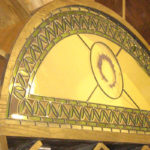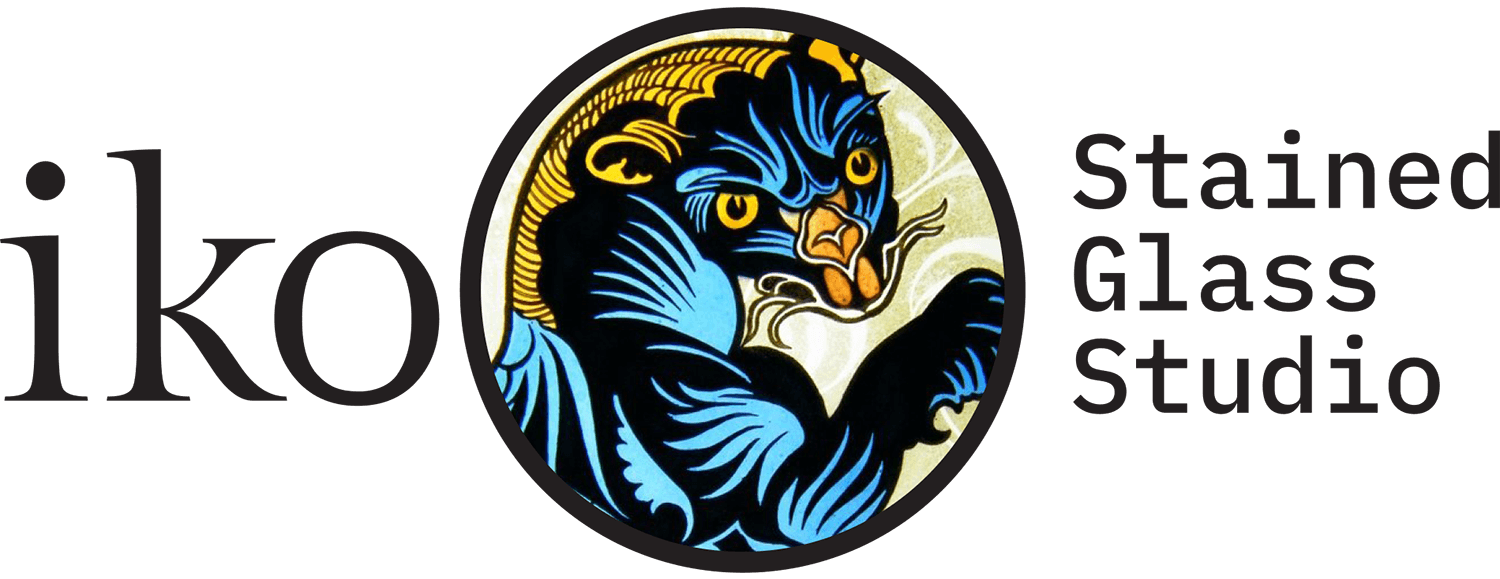[vc_row][vc_column][vc_column_text]
THE PROJECT
A stained glass windows begins life as a scaled, hand-drawn design that is then hand-painted in watercolours so as to capture the intensity of the glass colours. A stained glass design can also be created from a photograph, often a portrait or image proposed by my clients.
 CUT LINES
CUT LINES
Once the design has been approved, it is then scaled up to full size using a plotter. Then we carefully apply the cut-lines to the design so that they correspond to changes in the glass mosaic as well as the structural requirements of this technique. It is important that these cut-lines work to enhance, rather than detract from the overall beauty of the final stained glass window. The cut-lines are just over a millimetre thick and represent where the lead will be used. We use the full range of different leads available on the market to maximise the beauty of the final window.
GLASS CUTTING
Using the highest quality coloured glass available, and sometimes even two different coloured glasses that will be layered to obtain the required colours, the glass is then hand cut, with utmost precision. To do this is we use diamond wheels to grind the glass until it fits perfectly into the cut-lines, helping ensure the final window meets the exact measurements.
 PAINTING STAGE
PAINTING STAGE
Painting the glass is undoubtedly the most difficult phase in the creation of a stained-glass window. The pieces are painted with Grisalia, a technique which mixes a dark pigment, made from oxides and finely ground glass, with a special medium that contains essential oils, Arabic gum, or water depending upon the painting techniques being used.
 The painting is built up in layers, each layer being baked in a kiln at 650°C. This firing bonds the Grisalia to the glass. Some designs call for coloured transparent glazes to be applied and these are fired at slightly lower temperatures, after the painting and shading has been completed.
The painting is built up in layers, each layer being baked in a kiln at 650°C. This firing bonds the Grisalia to the glass. Some designs call for coloured transparent glazes to be applied and these are fired at slightly lower temperatures, after the painting and shading has been completed.
We carefully layout the fired glass pieces on a light table to check the quality and shading of every individual piece, and the overall design. Quality control is of great importance to IKO Studio
 LEADING UP : WEAVING WITH LEAD
LEADING UP : WEAVING WITH LEAD
The lead strips have an ‘H’-shaped cross section. The lead is particularly malleable and is curved around the glass mosaic. The pieces are are then soldered together to hold the glass in position, ready for the cementing stage.
 CEMENTING AND FINISHING
CEMENTING AND FINISHING
The window is then cemented with a special lead cement made by us, to our special blend of chalk, linseed oil, a binding agent and a black pigment that helps darken the lead for polishing. The cement fills the spaces between the lead and the glass and hardens rendering the window weatherproof, for approximately 100 years. The window is then cleaned and brushed and the lead hand polished to perfection. The finished window is then ready to be installed. Many stained glass windows last over 100 years, after which the lead can be easily replaced and the window re-cemented, extending its life still further.
[/vc_column_text][/vc_column][/vc_row][vc_row full_width=”” parallax=”” parallax_image=”” bg_type=”” parallax_style=”” bg_image_new=”” layer_image=”” bg_image_repeat=”” bg_image_size=”” bg_cstm_size=”” bg_img_attach=”” parallax_sense=”” bg_image_posiiton=”” animation_direction=”” animation_repeat=”” video_url=”” video_url_2=”” u_video_url=”” video_opts=”” video_poster=”” u_start_time=”” u_stop_time=”” viewport_vdo=”” enable_controls=”” bg_override=”” disable_on_mobile_img_parallax=”” parallax_content=”” parallax_content_sense=”” fadeout_row=”” fadeout_start_effect=”” enable_overlay=”” overlay_color=”” overlay_pattern=”” overlay_pattern_opacity=”” overlay_pattern_size=”” overlay_pattern_attachment=”” multi_color_overlay=”” multi_color_overlay_opacity=”” seperator_enable=”” seperator_type=”” seperator_position=”” seperator_shape_size=”” seperator_svg_height=”” seperator_shape_background=”” seperator_shape_border=”” seperator_shape_border_color=”” seperator_shape_border_width=”” icon_type=”” icon=”” icon_size=”” icon_color=”” icon_style=”” icon_color_bg=”” icon_border_style=”” icon_color_border=”” icon_border_size=”” icon_border_radius=”” icon_border_spacing=”” icon_img=”” img_width=”” ult_hide_row=”” ult_hide_row_large_screen=”” ult_hide_row_desktop=”” ult_hide_row_tablet=”” ult_hide_row_tablet_small=”” ult_hide_row_mobile=”” ult_hide_row_mobile_large=””][vc_column width=”1/1″][vc_btn title=”Follow our Online Course” style=”modern” shape=”rounded” color=”success” size=”lg” align=”center” i_align=”left” i_type=”fontawesome” i_icon_fontawesome=”fa fa-adjust” i_icon_openiconic=”vc-oi vc-oi-dial” i_icon_typicons=”typcn typcn-adjust-brightness” i_icon_entypo=”entypo-icon entypo-icon-note” i_icon_linecons=”vc_li vc_li-heart” css_animation=”appear” link=”url:http%3A%2F%2Fwww.ikostudio.it%2Fen%2Fonline-stained-glass-course%2F||target:%20_blank” button_block=”” add_icon=”” i_icon_pixelicons=”vc_pixel_icon vc_pixel_icon-alert”][/vc_column][/vc_row]
